Stardew Valley is an indie game created by Eric Barone from ConcernedApe, and can be played on almost any platform, but I played the iOS version. I chose this game because it’s one of the few games my female friends back home played when I was in high school. I wasn’t interested in gaming at the time, but the aspect of relationship-building in this game intrigued me and seemed to be one of the main appeals for female and male players alike. Playing like a feminist allowed me to hone in on the feminist aspects of the game that add to its appeal, and critique how the game could be improved further.
Shira Chess writes about the ludonarrative potential of video games to challenge norms and build empathy for the experiences of diverse identities. In Stardew Valley, a player takes on either a female or male identity, and can then choose to marry characters of either gender in the game. By allowing homosexual relationships, Stardew Valley challenges traditional, heteronormative narratives often found in games. This is one of the ways that Stardew Valley provides a space for exploring and representing queer experiences.
In addition, both male and female characters are seen performing tasks traditionally associated with either gender. For example, Emily, a female character, works as a blacksmith – a profession traditionally seen as masculine. Conversely, Shane, a male character, is found taking care of chickens – a job often stereotyped as feminine. These choices by the game creator challenge traditional gender roles and expectations.

Gift-giving in Stardew Valley is a crucial part of gameplay, as it strengthens your relationships with the characters in the town. In traditional storytelling, gift-giving is often portrayed as a transactional event that solidifies the giver’s power or dominance. However, in Stardew Valley, characters have personalized reactions to different items, suggesting a deep understanding of their unique likes and dislikes, which means gift-giving is not just an economic transaction, but a personal one. Overall, instead of emphasizing possession or dominance, it focuses on mutual respect, understanding, and emotional connection, which aligns more with feminist values of equality, reciprocity, and intimacy.
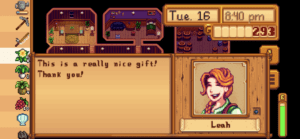

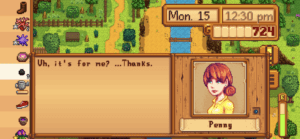
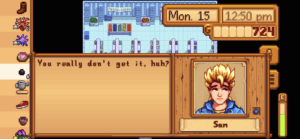
Above are a few examples of character responses to recieving good and bad gifts. As I mentioned, all of the characters have their own unique likes and dislikes when it comes to gifts, but there were few noteworthy trends in the types of gifts female and male characters liked, and their clearly gendered reactions to them. I gave coal to both Sam and Penny, and the reactions of each show a stereotypical gendering of the character’s personality. Penny is more agreeable and polite when receiving this unfavorable gift, which is reflective of a broader societal expectation that women should be agreeable and accommodating, even in unfavorable circumstances. I gave a foraged flower to both Leah and Alex, and it’s worth noting that the difference in enthusiasm in their reactions reflects the fact that the majority of female characters in the game have a strong positive reaction to receiving flowers as gifts. This could be interpreted as a reflection of traditional gender stereotypes, where flowers are often seen as a suitable gift for women. While it can be said that aspects of this gift-giving mechanism could unintentionally perpetuate gender stereotypes, it’s also essential to reiterate the diverse personalities of both the female and male characters in the game, each with their own likes, dislikes, and storylines.
The ability of this game to appeal to women and non-men already makes it a part of feminist empowerment. Shira states that this movement requires diverse communities to be playing video games. Given the capitalist framework within which games are created, by having more feminists play video games and thereby increasing demand for games with feminist values in mind, the market will be compelled to create such games.
Discussion Questions:
Could Stardew Valley be more overt in its handling of feminist themes without detracting from the core gameplay experience?
How does the freedom to choose partners of any gender in Stardew Valley contribute to its potential as a platform for exploring queer narratives, and could the game do more to delve into these narratives beyond simply allowing same-gender relationships?
How does the gift-giving mechanic in Stardew Valley challenge or reinforce traditional gender norms and expectations? Are there ways this system could be further evolved to more deeply engage with feminist and queer perspectives?
Extra moments of particular enjoyment in the game:


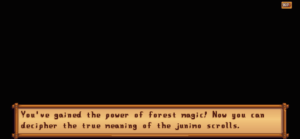
The wizard in town gave me a seemingly psychedelic potion triggering the cutely designed “trip” pictured above. It gave me the ability to speak the language of the forest!
This minigame “Pirate King” hidden inside an arcade machine in the saloon was a fun surprise!

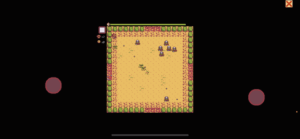
I particularly liked the mining, which is akin to a game of chance as discussed last week. Picking each rock is an opportunity to find a mineral or geode, which can also be opened to discover a new type of rock. Here’s my current collection in the museum:)
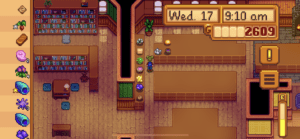
Abigail was on point here lolol
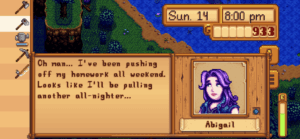
This is the first video game that I’ve ever truly enjoyed, and I plan to finish it this summer. I’ve spent way too much of my sleep-deprived finals week playing this game and discovering its pixelated charm.



